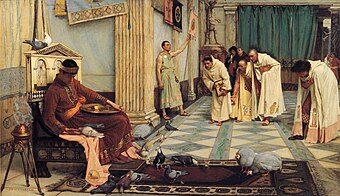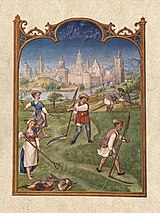古典时代晚期

古典时代晚期又称作古代晚期、晚古时期或近古代(英语:Late Antiquity),是历史学上的术语,意指古典古代到中世纪之间的期间,地区包含了欧洲的大部分和环地中海地区,历史学者彼得·布朗(Peter Brown)把这段期间界定在3世纪到8世纪,一般而言这段时期的开端是罗马帝国的三世纪危机(公元235年–284年),在7世纪东罗马帝国的皇帝希拉克略在位期间遭受阿拉伯帝国穆斯林入侵结束。
罗马在皇帝戴克里先在位时,社会、文化以及组织出现重大转变,罗马开始出现东西部的概念,在君士坦丁大帝在位期间除了基督教化,甚至有更大的举措-迁都拜占廷,并改名为君士坦丁堡,当4世纪日耳曼人大举迁徙使476年西罗马帝国灭亡时,蛮族也在各地建立王国,文化也呈现日耳曼-罗马的形式,欧洲文化的基础就在日耳曼族和基督教传统间混合而成。
欧洲的人口和知识科技也在此际慢慢转变,社会崩溃直到文艺复兴才开始恢复,而在西罗马帝国灭亡到中世纪之间的时期,被称为所谓的黑暗时期,源自近古代较狭义的定义。
辞源
[编辑]德文"Spätantike"字面的意思即古典时代晚期,在20世纪前就被广为人知的奥地利史学家阿洛伊斯格尔所引用[1],而比较盛行的英文相关著作是彼德布朗所著的“古典时代晚期的世界”(1971),是由爱德华·吉朋对古典文化的观点出发,质言之爱德华所著的“古典时代晚期的出现”予以相当的新的见解,近代瑞秋爵士的著作“中世纪的出现”,更建立了一个西方文化新的典范[2]。
这段时期最初要追溯到戴克里先 (公元284年–305年)创建四帝共治制到中世纪早期之间,这段期间为中世纪的文化奠定基础,以及发展出基督教化的政权,在欧洲世界外面还有所谓的拜占廷帝国,即其宿敌伊斯兰信徒,移进欧洲的日耳曼族,例如:东哥德人以及西哥德人,都接受了罗马留下来的传统,在使用古典时代晚期的词汇时,其实意涵不论社会抑或文化都是古典时代即将结束,而欧洲进入中世纪,当提及“中世纪初期”和“拜占廷初期”等词汇均指古典时代结束,而提及民族大迁徙则意谓西罗马帝国的灭亡,以及日耳曼人依据自己的势力范围建立王国,其缘于418年哥德人成为罗马的附庸[3]。
宗教
[编辑]在古典时代晚期较为重大的转变是亚伯拉罕诸教:基督教、犹太教以及伊斯兰教,比利时的历史学家亨利·皮雷纳则认为阿拉伯在古典时代晚期进入到中世纪扮演举足轻重的角色。

基督教最具代表性的里程碑在君士坦丁大帝(公元306年–337年)的谋臣,即担任主教的优西比乌使君士坦丁信奉基督教,并于次年颁布米兰诏令,以获取东部帝国人民支持以击败宿敌李锡尼(公元308年–324年),在4世纪末狄奥多西大帝尊奉基督教为国教,古罗马昔日的观念完全改观,彼得布朗曾言:“这充满神圣的精神。”[4]
无可否认的君士坦丁在基督教史上扮演举足轻重的角色,并在325年召开第一次尼西亚公会议,优西比乌依据尼西亚信经确立圣父圣子同质的关系,也订定复活节为基督教的节日[5]。
修道制度最早源于3世纪的埃及,他们在教堂之外作修行,直到8世纪成为基督教的规定,修行制度并非基督教在古典时代晚期才有的举措,但对当时确实有重要的影响,其他直到注意的措施包含了“茹素”、“圣人”(若该人对宗教有所贡献在死后册封圣号) [6],圣愚也是在该时其出现人们把看似游民的传教士之言解释为圣谕,此举在后来的帝俄国内时分风行,“登塔”是指教士在五十呎高的塔上修行长达40余年,此举在拜占廷帝国风行。
伊斯兰教在7世纪初现的阿拉伯民族间,当时阿拉伯人并不团结,分散于拜占廷帝国和波斯萨珊王朝的境内,当阿拉伯建立伊斯兰帝国后,阿拉伯占领了北非以及位于西班牙的西哥德王国,甚至入侵到法国境内[7]。
古典时代晚期古罗马宗教于4世纪在优西比乌的建议下重要性被基督教取代,然而两个宗教之间相互影响产生综摄的过程,也有新的思想出现例如:诺斯底主义或著是新柏拉图主义。
世俗以及教士
[编辑]4世纪基督教社群开始出现,分歧产生于领导阶层能否是平信徒以及必须禁欲[8],他们企图把罗马在公、私领域的传统抹去,企图心与亲属之间的亲情在拉扯,能否和异教徒联姻成为主要课题,这与之后教士是否需要单独身的议题并不相同,在古典时代晚期基督教有时接受没有婚姻的性关系,以期规范在都市的教士,独身已经和现实脱节,都市教士已经融入都市上流阶级中的菁英,限制婚姻不符实际传教需求[9]。

政治变迁
[编辑]古典时代晚期的政治以及社会基础围绕着罗马帝国而变迁。
罗马公民在二到三世纪被课征沉重的赋税,以供应掌权者的公共娱乐,这些制度可以追溯到安敦尼王朝,安敦尼王朝是罗马历史中最为强盛的年代,然而到了后代没有皇帝可以超越他们的成就,然而这些成为传统的制度反倒拖累之后的罗马,在君士坦丁大帝建成新都君士坦丁堡之后,造成古典时代晚期所谓的上层阶级被集中管理,他们家境良好又可受教育,古典的教育使其拥有知识足以晋升元老院,古典时代晚期的社会更加的官僚化,甚至可以进而被推举为皇帝,共和时代的元老院议员珠光宝气的象征,后来被拜占廷的皇室所沿用[10],这也显了御用的内阁顾问也是有可能成为贵族,进而出席宫廷的会议参与决策,由此可见奥古斯都的决策往往被其亲信以及顾问所左右。
相关条目
[编辑]参考文献
[编辑]- ^ A. Giardana, "Esplosione di tardoantico," Studi storici 40 (1999).
- ^ Glen W. Bowersock, "The Vanishing Paradigm of the Fall of Rome" Bulletin of the American Academy of Arts and Sciences 49.8 (May 1996:29-43) p 34.
- ^ A recent thesis advanced by Peter Heather of Oxford posits the Goths, Hunnic Empire, and the Rhine invaders of 406 (Alans, Suevi, Vandals) as the direct causes of the Western Roman Empire's crippling; The Fall of the Roman Empire: a New History of Rome and the Barbarians, OUP 2005.
- ^ Brown, Authority and the Sacred
- ^ Eusebius of Caesarea, Vita Constantini 3.5-6, 4.47
- ^ p96 Islam and Global Dialogue Roger Boase, Hassan Bin (FRW) Talal, Ashgate Publishing, Ltd., 2010
- ^ For a thesis on the complementary nature of Islam to the absolutist trend of Christian monarchy, see Garth Fowden, Empire to Commonwealth: Consequences of Monotheism in Late Antiquity, Princeton University Press 1993
- ^ Jerome of Stridon wrote in c. 406 the polemical treatise Against Vigilantius in order to, among other disputes concerning relics of the saints, promote the greater spiritual nature of celibacy over marriage
- ^ Brown (1987) p. 270
- ^ Cf. the compendious list of ranks and liveries of imperial bureaucrats, the Notitia Dignitatum
参考书目
[编辑]- Peter Brown, The World of Late Antiquity: from Marcus Aurelius to Muhammad (AD 150-750), (London: Thames and Hudson) 1989, ISBN 0-393-95803-5
- Peter Brown, 1987. "The World of Late Antiquity Ad 150-750" in A History of Private Life: 1. from Pagan Antiquity to Byzantium, Paul Veyne, editor, ISBN 0-393-95803-5
- Peter Brown, Authority and the Sacred : Aspects of the Christianisation of the Roman World, Routledge, 1997, ISBN 0-521-59557-6
- Peter Brown, The Rise of Western Christendom: Triumph and Diversity 200-1000 AD, Blackwell, 2003, ISBN 0-631-22138-7
- Averil Cameron, The Later Roman Empire: Ad 284-430, Harvard University Press, 1993, ISBN 0-674-51194-8
- Averil Cameron, The Mediterranean World in Late Antiquity Ad 395-600 (Routledge History of the Ancient World), 1993, ISBN 0-415-01421-2
- Averil Cameron et al. (editors), The Cambridge Ancient History, vols. 12-14, Cambridge 1997ff.
- John Curran, Pagan City and Christian Capital: Rome in the Fourth Century, Clarendon Press: Oxford, 2000.
- Peter Dinzelbacher and Werner Heinz: Europa in der Spätantike. Primus, Darmstadt 2007.
- Tomas Hägg (ed.) "SO Debate: The World of Late Antiquity revisited," in Symbolae Osloenses (72), 1997.
- A.H.M. Jones, The Later Roman Empire, 284-602; a social, economic and administrative survey, vols. I, II, University of Oklahoma Press, 1964.
- Kitzinger, Ernst, Byzantine art in the making: main lines of stylistic development in Mediterranean art, 3rd-7th century, 1977, Faber & Faber, ISBN 0571111548 (US: Cambridge UP, 1977)
- Bertrand Lancon, Rome in Late Antiquity : AD 313 - 604, Routledge, 2001.
- Lee, A.D., Pagans and Christians in Late Antiquity: a Sourcebook, Routledge: New York, 2000.
- Noel Lenski (ed.), The Cambridge Companion to the Age of Constantine, Cambridge University Press, 2006.
- Sam N.C. Lieu and Dominic Montserrat (eds.), From Constantine to Julian: Pagan and Byzantine Views, A Source History, Routledge: New York, 1996.
- Maas, Michael, The Cambridge Companion to the Age of Justinian, Cambridge University Press, 2005.
- Ramsay MacMullen, Christianizing the Roman Empire A.D. 100–400. New Haven, CT; London: Yale University Press, 1984.
- Stephen Mitchell, A History of the Later Roman Empire. AD 284-641, Blackwell, London 2006.
- Barbara Rosenwein, A Short History of the Middle Ages, 2nd edition, Broadview Press, New York, 2004, p. 30-39.
- Rostovtzeff, Michael Ivanovitch, (rev. P. Fraser), The Social and Economic History of the Roman Empire, Clarendon Press: Oxford, 1979.
- El Housin Helal Ouriachen, La ciudad en la Bética tardoantigua, Berlín, 2011, ISBN 978-3-8443-4477-6.
外部链接
[编辑]- New Advent — The Fathers of the Church(页面存档备份,存于互联网档案馆), a Catholic website with English translations of the Early Fathers of the Church.
- ORB Encyclopedia's section on Late Antiquity in the Mediterranean from ORB
- Overview of Late Antiquity, from ORB
- Princeton/Stanford Working Papers in Classics (页面存档备份,存于互联网档案馆), a collaborative forum of Princeton and Stanford to make the latest scholarship on the field available in advance of final publication.
- The End of the Classical World(页面存档备份,存于互联网档案馆), source documents from the Internet Medieval Sourcebook
- Worlds of Late Antiquity, from the University of Pennsylvania

